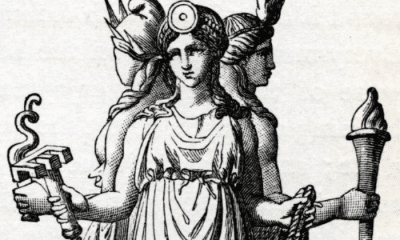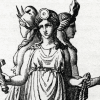Greek
Dike: The Greek Goddess of Justice
The Greek people were so concerned with justice that they had more than one goddess devoted to it. Read on to learn about Dike, the goddess of justice in the human world!
Ancient Greek culture passed on many ideas and values that are still part of Western society today. In mathematics, literature, art, and philosophy their ideas remain influential.
Many people, however, believe that the greatest contribution the ancient Greeks made to the modern world was their concept of law and justice.
The Athenians are credited with creating the world’s first democracy and the first system of courts with a trial by jury. These ideas, which were later adapted by the Romans, form the basis for our legal system to this day.
The Greek believed that one goddess was responsible for overseeing this human system of justice. While Themis concerned herself with divine law, Dike was the goddess of human law.
Although she was a minor goddess, Dike was one of the most influential members of the Greek pantheon. By overseeing and maintaining human law, she kept society stable and structured.
The Goddess of Justice and Her Family
Dike was one of the daimones, a group of minor deities in Greek mythology. She personified the idea of justice.
Unlike many daimones, however, Dike had a personality that extended beyond just the execution of her duties. The goddess of justice was highly involved in and affected by the affairs of the world.
She was one of the daughters of Zeus and his second constort, the Titaness Themis. As both of her parents were deities of law and the natural order, she was closely aligned with them.
Dike was most often associated with two of her sisters. Eirene was the goddess of peace and Eunomia was the goddess of order.
Together, the three sisters personified the states that were necessary for a society to function properly. Justice had to be maintained and peace assured for order to exist.
If all of these things were in place, the Greek people believed, society would be prosperous and pleasing to the gods.
In Athens and a few other cities, the goddess of justice and her sisters were particularly revered. They were given the role of the Horae, the goddesses of the hours and the proper progression of time.
Dike’s mother was also a Greek goddess of justice, but the two ruled over different forms of the concept.
Themis was the goddess of divine justice, enforcing the rules of the gods and the natural laws of the world. Dike, meanwhile, was more representative of human laws.
Dike spent her time watching the actions of human judges, lawmakers, rulers, and cities. In Athens, she was associated with their judicial system of trials in court.
She was often described as the associate or attendant of her father, Zeus. As the king of the gods he represented not only divine law but the models of leadership and lawfulness that other rulers should aspire to.
According to one source, Dike was particularly impacted when she saw injustice. One writer said that she threw herself before her father’s throne in tears when she witnessed a corrupt judge pervert justice.
Dike was not specifically a goddess of punishment, although she could bring consequences to those who did not act justly. She also rewarded those who upheld the law and acted with virtue.
Although she was typically an orderly and peaceful goddess, even being said by some to personify purity, Dike was violent on occasion. One popular representation of her in Greek art showed the goddess of justice beating her opposite, Adikia, the personification of injustice.
My Modern Interpretation
Although Dike was a daimone, she was a major force in Greek culture. In urban areas particularly, her influence was vital.
Greek society valued law, order, and stability above almost all else. Everything from the class structure to property issues were thought to be ordered by both natural and human law.
When these laws were in conflict with one another, divine natural law took precedence. It was therefore one of Dike’s roles to ensure that human law followed the laws of the gods as closely as possible.
If either of these sets of laws were to break down, the Greek people believed, chaos would ensue. Violations of natural law, in particular, could be disruptive enough to threaten the stability of the entire universe.
By aligning natural law and human law as closely as possible, therefore, Dike was one of the major protective deities of the ancient world. As a goddess of justice she helped to ensure that society, and therefore the entire world, functioned in a stable and orderly way.
The importance of Dike can be seen, in part, by her epithet. The goddess of justice was sometimes called Astraea, “The Lady of the Stars.”
The constellation Libra, the scales, represented both Dike and Themis. The balanced scales of justice represented the stability that these goddesses brought.
Dike was also important enough to influence modern ideas of justice.
The personification of Lady Justice is still based on the image of Dike, which was very similar to that of her mother as well. The goddess of justice was usually shown as a slender young woman in a long gown who held the balancing scales.
Unlike her mother, Dike did not typically carry a sword in her imagery.
Images of justice that are based on Themis often hold a sword at their side. This does not represent violence, but the goddess’s ability to slice through matters to separate truth from fiction.
Themis had this ability as the goddess of natural law. As a goddess of human law, however, Dike sometimes had trouble separating the two.
Although modern legal imagery is based on the iconography of Dike, there is one significant difference.
In ancient Greece art, the goddess of justice did not wear a blindfold. The idea of blind justice is a modern one, and the blindfold was added to Lady Justice iconography relatively recently.
In Greek culture, justice was based partially on social class, gender, and age. Because the ordering of society was part of natural law, Dike’s human justice had to take into account a person’s place in the structure of society.
In Summary
In Greek mythology, Dike was the personification of justice. She was particularly associated with justice in human affairs, while Themis was associated with divine and natural law.
She was one of the daughters of Zeus and Themis who had domain over order, law, and stability. Along with the goddesses of order and peace, she kept human society stable and prosperous.
She and her sisters were particularly important in Athens and other cities, where the rule of law was paramount to keeping urban society functioning. There, they were called the Horae, the goddesses who ensured the proper ordering of time.
By keeping human society stable and aligning human law with that of nature, Dike was a protective goddess. Protecting justice and rewarding those who upheld it kept the fabric of society, and the world at large, from unravelling.
Dike was far more influential than most other minor goddesses. This can be seen in the ways her iconography has been passed down to the modern world with the imagery of the scales of justice and the classical-looking personification of it.



